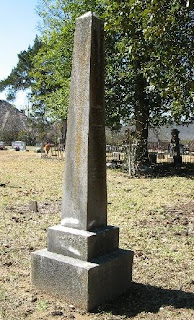
Mount Bluff Cemetery is located in a beautiful wooded glen, with trees that are covered with hanging moss so typical of parts of Mississippi. This old cemetery is tucked away in a northwest corner of Madison County, a part that was originally located in Yazoo County, near the town of Flora. The old Balfour family cemetery that dates to the early 1800's is a portion of this larger cemetery area.
Within Mount Bluff cemetery are a number of old graves with unique gravestones and grave markers. But one of the most unique is the pictured here that marks the grave of Miss Eugenia R. Davis. Miss Davis was just months away from her 18th birthday when she died on September 17, 1853.

At the time the U. S. Census was taken in 1850, Eugenia R. Davis was 15 years old and was living in the household of William and Elizabeth Gartley. William, born in Louisiana, was a planter by occupation. His wife was born in Mississippi. Also living in the household were three children with the surname of Davis, Mary E., age 8, Robert V., age 10, and William H., age 13. In addition to the Davis children, three children with the surname of Gartley shared the household, and their names were Martha, age 19, Julia, age 17, and William F., age 15. Since familial relationships were not shown on the 1850 census, it is impossible to determine what relationship existed between the Gartley family and the Davis children. Perhaps the Davis children were nieces and nephews of William or Elizabeth Gartly, or possibly this was an early "blended" family, formed by a widow and a widower who each had children before their marriage to each other.
Three Gartley family members are buried in Mount Bluff Cemetery, including William Gartley's parents, Colonel Gartley and his wife Julia. Elizabeth Gartley, William's wife, who apparently died just four years after Eugenia Davis's death, is also buried in this cemetery.












































